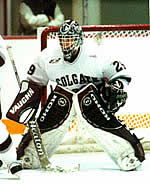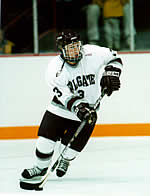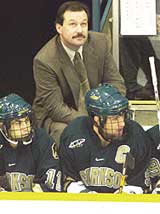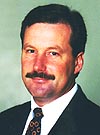How ‘Bout Them Yankees?
In the last month, this column’s praise has sent Boston College into a six-game tailspin and UMass-Lowell into one that lasted five games. Last week, it jinxed the St. Louis Rams. (Yeah, baby!)
So let’s talk baseball. Specifically, let’s talk about the unbeatable New York Yankees.
Great pitching staff yada yada yada.
Derek Jeter yada yada yada.
Jason Giambi yada yada yada.
[nl]Mariano Rivera yada yada yada.
Bernie Williams yada yada yada.
Jorge Posada yada yada yada.
Roger Clemens yada yada yada.
Mike Mussina yada yada yada.
Andy Pettitte yada yada yada.
The Yankees are clearly the best team in baseball. Positively unbeatable.
A Gutsy Performance
Last Friday night, UNH defenseman Mick Mounsey inadvertently stepped on goaltender Michael Ayers’ wrist, slicing a tendon. On Tuesday, Ayers had the necessary surgery, which produced a better than expected prognosis: he would be out for 3-to-6 weeks.
What’s remarkable, though, is what happened between the injury and the surgery. Wearing a brace and playing in considerable pain, Ayers backstopped UNH to a 2-2 tie at Maine, almost certainly saving the Wildcats from a pivotal sweep with 33 saves.
Following the second-period injury on Friday, Ayers had been rushed to Eastern Maine Medical Center in Bangor. A doctor informed him that surgery was required.
“I told him I really wanted to play in [Saturday’s] game, and I asked him if there was any way I could delay the surgery, and he said that was possible,” said Ayers. “He told me that I couldn’t do any more damage [to the wrist], so I could try and play.
“It bothered me a lot. Covering up the puck was really hard. And the one [Colin Shields slapshot] at the end, the cannon. It hurt a lot to catch that.”
Without question, Ayers’ return inspired his teammates.
“You thought there was no way he was going to be able to come back,” said David Busch. “We got word late [Friday] night that he was okay, and we were all relieved. It’s tough to play in a building like [Alfond Arena], and that gave us so much confidence to see him back there.”
The netminder’s courage was also not lost on coach Dick Umile.
“Once the hand specialist said that he wouldn’t do any more damage, I let him decide what he wanted to do,” said Umile. “It wasn’t my decision. He really wanted to play.
“I’m so proud of him. It was obviously very painful for him out there, but he did a good job. His effort was incredible.”
The Other UNH Goalie
Matt Carney, who has been sidelined for six games following a concussion, has been cleared to play this weekend. With his availability in question and Ayers undergoing the knife, the Wildcats added senior goaltender Dan Carney — no relation — to the roster. Carney last played for UNH’s club team, the New Hampshire Moose.
A Moment in the Spotlight
UMass-Lowell found itself in much the same position as UNH a few weeks back when Jimi St. John was sidelined with an elbow injury. Suddenly without a backup to Cam McCormick, the team scoured the campus for an NCAA-eligible goaltender. The River Hawks found one working in the athletic office.
Matt Carroll, a junior who had last played varsity hockey at Masconnomet High School three years ago and only intramural hockey since then, became the solution. Instead of cheering from the stands, he became a River Hawk himself. He was quickly welcomed to the team in the first practice.
“I’d been watching them from afar,” he said. “It was a dream just to go practice with them. Ever since I was told about it, I was on cloud nine. When I actually got out there, I was nervous at first.
“[But] they were really excellent out there. It was a really good feeling to be out there with them. After Coach told me at the end of that practice that I’d be dressing the next night — Friday night against Maine — from that point on all of the guys on the team were really nice to me. They really tried to make me feel comfortable. It was then I realized how much they were a team.”
Of course, taking to the ice for his first game in years and at the highest possible collegiate level prompted a few butterflies.
“I was nervous even in high school when I’d go out,” he said. “There’d be all the kids I knew in the high school — 100 kids max — would be at the games. But the Maine games were a couple thousand people. It was definitely new.
“I just tried to keep my head away from the stands and not look and see all the people, just skate around and do what I’ve been doing for years. Just try to stop some of the warmup pucks. I felt pretty good out there actually. It was definitely a great feeling to finally take Division I ice.”
Initially, Carroll found himself desperately hoping that he wouldn’t have to play.
“The first game I was, like, ‘Cam, please don’t get hurt. I don’t want to go out there and maybe embarrass myself or something,'” he said. “But the second game, after seeing them lose to Maine the first night, the second night I just felt that even if I’d gone out and made a fool out of myself, I didn’t care.
“I’m not that bad. I really think I could have held my own. Obviously, I don’t want Cam to get hurt, but I was thinking to myself that if he did have to come to the bench, I think I would have a great time out there. I don’t think I’d do that bad. I would have loved it.”
With St. John healthy again, Carroll has returned to the stands, but wouldn’t have changed a thing.
“When you’re six years old and you’re waking up at 6 a.m. to go skate, you don’t really realize then that you’re going to be doing that for a long time,” he said. “It’s been about 15 years since I first began putting skates on and maybe 11 months out of every year.
“You graduate high school and figure, all right, that’s it. Play intramural would be as close as you’d get. Division I and all that was what your dream was, what you were shooting for.
“When you finally get to do it, even if it’s just my position, to sit a bench and skate around during warmups with them, that’s fine by me. It was a dream come true. I loved every second of it.”
Two Goalies Or Else
UNH and Lowell weren’t just being cautious when they sought a backup goaltender. Although the penalty for dressing only a single netminder had been just a bench minor in the past, it now constitutes a forfeit.
“It was changed a year ago,” says Hockey East Commissioner Joe Bertagna, who also serves on the NCAA Rules Committee. “What was happening in women’s hockey, for example, is that Minnesota-Duluth had a situation where one goalie had some tournament so they basically said that they’d take their two-minute penalty at the beginning and play with one goalie and that’s the way it’s going to be.
“[The Rules Committee] thought about it. Division III women’s programs, many of them only have one goalie in school. If that one goalie gets hurt, you have to stop the game and put the equipment on somebody else.
“So the Rules Committee decided that if you’re going to be a full-fledged varsity program, there are certain responsibilities you have to bear and one of them is that you have to have two goaltenders. I don’t know how you can run a team practicing with just one.
“So we decided to stiffen the rule. It’s caused a little bit of a problem with Division III women. Many programs may have rushed to varsity status, but we’ve stuck to our guns.”
There is some wiggle room, but only a little.
“The book allows for extenuating circumstances,” says Bertagna. “For example, if you travel to Clarkson and St. Lawrence for a weekend and your goalie gets hurt on Friday night. That would be extenuating circumstances. You can play the Saturday game with one goalie because logistically to get a goalie up there would [be difficult] and it’s a one-time thing.
“Some of the women’s Division III programs have been trying to claim extenuating circumstances for the entire season that they only have one goalie and we’ve not budged on that. We’ve said no.
“We’ve granted a number of waivers this year for injury-related situations. We had a situation at Lowell a number of years ago where we got a call from Tim Whitehead who said, ‘Here’s my situation. I’ve got three goalies. One won’t be eligible until January. One has to attend a funeral in Ontario. His plane lands at 5 o’clock and we have a seven o’clock game. He’ll probably be in uniform by the time we drop the puck, but I can’t guarantee it.’ We granted the waiver for that because, again, it was a one-time thing; it wasn’t a systemic thing.”
In UNH’s case, the Wildcats would have probably been expected to find another goalie somewhere, as they did with Dan Carney, if Matt Carney had been unable to dress.
“The rulebook says that you have to start the game with two in uniform, dressed and ready to play,” says Bertagna. “You cannot put the equipment on and give privileges to somebody [else] until all the goalies that started the game have been incapacitated. So both goalies would have to go down with injury before you could stop the game and dress a third guy.”
The Newest Zebra
Most fans view referees the same way kids look at eating their vegetables. Both are a necessary evil. Conrad Hache, however, seems to have become more of a lightning rod for criticism in his first year with Hockey East than any other in recent memory.
There have been complaints about poor judgement in handing out, or not handing out, penalties. Some of those complaints have been valid.
However, what has caught this writer’s attention more than anything is the quick trigger with assessing bench minor penalties. Hache has already nailed UNH’s Dick Umile, Northeastern’s Bruce Crowder and Lowell’s Blaise MacDonald. Perhaps I’ve missed some, but I don’t recall any others being assessed this year. If one referee has all, or even the bulk of the totals, then that would seem to be cause for concern.
“There is a warning procedure,” says Supervisor of Officials Brendan Sheehy. “We’ve taken zero tolerance with assistant coaches. If an assistant coach speaks up for anything, the referee will go over to the coach and tell him that the next thing he hears from the bench, the situation will be addressed and there will be a bench minor.
“They give the head coach more latitude. However, if [unacceptable] language is involved or if it is something personal, a bench minor will be called. If they’re arguing a certain point, that’s one thing. But if there is language involved or something personal involved, they immediately give them a bench minor in those cases.”
I was at the Lowell-Maine game where MacDonald was assessed a bench minor, resulting in a five-on-three advantage that the Black Bears capitalized on to turn a tight 2-1 lead into a much more comfortable two-goal margin. And even though I was looking in that direction, I never saw anything that remotely looked like a warning.
Was improper language or something personal said?
MacDonald’s fault? Possibly. Crowder’s fault? Possibly. Umile’s fault? Possibly.
Hache has a chip on his shoulder? Possibly.
Referee Assignments
Considering the controversy just alluded to as well as his bottom-of-the-totem-pole seniority ranking, it was a surprise to see Hache sent to Maine last weekend to officiate the league’s marquee series. Which prompts a discussion of how assignments are handed out among the six referees.
“Brendan does the assignments in four blocks,” says Bertagna. “From the start of the year until mid-December or the Christmas break; the first of the year until the middle of February; the last three weeks of the regular season; and then the playoffs.
“We try to do a couple of things. We try to rotate guys so people don’t see the same [referees] all the time. Part of the reason you have these blocks that get smaller and smaller as the season goes along is that for those last two blocks, you finally have some ratings and observations that you can now factor in so if you have two coaches playing who have both rated someone low, then you could avoid assigning that referee to that game.
“It’s not an exact science. For example, last year before the quarterfinals we had four matchups that for one of our officials there was a team in each series that rated him very highly and a team in each series that rated him very lowly. There was no place to assign him where one coach wasn’t going to be upset.
“And some of these ratings are not all that deeply thought out. The coach that eventually got that guy, but hadn’t wanted him, when he won a game in that series, he wanted him the next night. That shows how deep some of the thoughts are.
“I don’t want to get into commenting on specific officials or assignments, but there is a rotation. No one wants to see the same guy in the same building all the time simply because familiarity breeds contempt.
“It was further compounded this year in that Scott Hansen, who works for both leagues, also was named to the Olympics, so he flew out [this week]. Jimmy Fitzgerald, who has been with Hockey East since the first year, got a job promotion that required that if he took the promotion, he’d have to give up officiating right away. So all of a sudden, two people were pulled from the pool, so it meant scrambling.”
Furthermore, the expectation that a high-profile series will warrant the league’s best referee isn’t realistic at this point of the season.
“That type of dynamic — a top-rated official — doesn’t come into play until those last couple of blocks where we actually have a body of information and ratings that we don’t have earlier in the season,” says Bertagna. “Also, the fans’ perceptions quite often have no bearing on our ratings and how we feel about the officials. Some fans have been writing emails about officials in games that they didn’t even see. So the fan opinion doesn’t really carry much weight in this particular topic.
“We have paid observers at every game, many of whom are former officials, some of whom are not. And we have Brendan and a fellow who are above that level of paid observer and go see a lot of games on their own. Then the coaches have ratings.”
In the case of the observers, the evaluating is quite detailed.
“A report is filed after every game by the observer which specifically rates every official in about 10 categories from demeanor to appearance to mechanics to judgement to game control,” says Bertagna. “The coaches do a less detailed report, more of a mid-year report.
“Brendan will sit down with officials from time to time with videotape and will go through an entire game and ask an official what he thought about this and that as part of a mentor process. And then if there is a pattern, [we can address it].
“One of the reasons we ask coaches is because a lot of them are embarrassed to drop a dime or if they lost a game sound like they’re complaining. But we tell them if they really think there is a pattern of behavior, we want to know about it because if collectively they just keep this to themselves, we have nothing we can address in that mentoring capacity.
“But if we start to build a file from the coaches that matches the observations of these observers have been filing game by game, that allows Brendan to sit down with an official and say, ‘You’re doing a great job in this-and-that, but you’re not keeping up with the play or your positioning isn’t great or you use of the assistant isn’t right.’
“Whatever that one area is, he can sit down and say this is what people are saying across a cross-section and this is what you need to work on.”
All that said, the league office is happy with the officiating work it has been receiving, especially considering the loss of veterans like Fitzgerald and, temporarily, Hansen.
“There isn’t one referee that we’re using now that we don’t feel very comfortable with and we aren’t going to ask back and have as a major part of our officiating crew next year,” says Bertagna.
Turning the Corner?
The Providence Friars have now won four of their last five and may finally be on the verge of fulfilling the promise that prompted league coaches to predict a first-place finish for them. They did lose to Northeastern, 3-2, on Friday night, but rebounded to defeat the pesky UMass-Amherst Minutemen.
“Anytime you get a win on the road in Hockey East, especially this time of year, to get you back to .500 you’re always happy,” says coach Paul Pooley. “BC obviously had a tough time on Friday night with them [going into overtime] and we had a tough time with them on Saturday. They’re a very young hockey club, but they come to play and they play well defensively. I was very happy with the victory.”
Recently Jon DiSalvatore and Drew Omicioli have earned league honors and sparked the Friar offense.
“Jon has been our best player all year and he’s reaping the rewards of his work ethic from day one,” says Pooley. “Drew is obviously a very talented player who has had success lately. We need him to continue to have that for us to be successful against the tough Hockey East teams we’ll face down the stretch.
“I’d throw [Devin] Rask and [Peter] Fregoe into that mix, too. I think the consistency of what we’re doing [has made the difference]. Our power play is starting to move up the Hockey East percentage chart from being below 10 percent. Now we’re in the middle of the pack. That’s a big part of what we’re doing.
“Consistency in practice and consistency in games is how you get points. That’s what they’re doing.”
The big concern for Providence, however, is its schedule. All seven of its remaining games are against Top 15 opponents.
“We’ve played ranked teams all year, so it isn’t intimidating,” says Pooley. “I think it’s going to be a challenge. But we’re excited because the teams ahead of us are the ones we want to catch.
“I think the opportunity is there for us if we can play solid, good hockey and continue to keep getting better then it’s an opportunity for us. This is what you want because you’re playing the teams ahead of you — except Northeastern . That’s what you want. You get to measure yourself to see how good you are. We’ll get a chance to see if we’ve improved in some areas or not.
“We love the challenge. We love the opportunity. It’s great to be the underdog going against the teams ahead of you.”
Quotes From The Beanpot
A downcast Pat Aufiero on being sidelined, likely until the Hockey East playoffs reach the FleetCenter: “It’s just a shame, my senior Beanpot. It’s such a shame.”
BU coach Jack Parker on his man advantage unit: “I thought we killed off a couple of our power plays tonight.”
Parker, when asked if he encourages defenseman Ryan Whitney to rush the puck: “He doesn’t need any encouragement…. He’s got a Tom Poti type of attitude offensively.”
Parker, when asked if it was a bigger incentive to beat BC or to simply avoid playing in the consolation game: “It would be a bigger incentive to beat Boston College if you were playing at the Skating Club at three in the morning.”
BC coach Jerry York on the effect of attrition on his lineup: “[It was] just old-fashioned hockey. We just scrambled the eggs up and mixed and matched.”
NU coach Bruce Crowder on his school’s Beanpot dry spell: “There’s no doubt that every time you walk around the campus at Northeastern — whether it’s the people in facilities or the professors or the cook in the cafeteria — they’re all giving you jabs here and there, Beanpot this, Beanpot that. For us it would be fantastic for the university and the alumni [to win it]. We just wanted to get in a position to play for it, and that’s what we accomplished [last Monday].”
Mike Ryan on NU captain Jim Fahey: “I don’t think I’ve ever seen a kid who wanted a Beanpot so badly. Just the look on his face. I think [on Monday] it really hit home how important this thing is.”
Ryan on playmaking linemate Jason Guerriero: “I knew right from day one. I sat down with Coach before the year started. [We were] going over some line combinations. Unfortunately, I wasn’t able to play the first few weeks of the season [because of mononucleosis] so I got to sit up in the stands and watch. He’s a kid that I stepped right up and said that I’d love to play with. He sees the ice extremely well, similar to [Graig] Mischler last year in that he’s pretty much a playmaker. We complement each other really well.”
Polls
This week I received several emails from readers wondering how Maine could have dropped one position in the poll after taking three of four points from second-ranked New Hampshire.
Oddities sometime do occur, but in this case the voters were on target. Maine did have a very successful weekend, but Colorado College deserved to leapfrog the Black Bears after sweeping top-ranked Denver in a home-and-home series.
Maine does seem to be coming on during the stretch drive for what seems like the umpteenth year in a row, but still has only the 12th-best winning percentage in the country. Putting it all together, number seven in the country (with a bullet) seems just about right for now.
Trivia Contest
Last week’s question asked what hockey team other than Boston University, Boston College, Northeastern and Harvard has played in the Beanpot? Since this projected to be a difficult question, you were encouraged to “think outside the box.”
As it turned out, a lot of readers found this quite easy. A lot! The answer was the 1993 Brown women’s team, which won the tournament.
Jason Morgan became the first back-to-back winner by beating a boatload of other correct responses. Once again, his cheer is:
“UNH – You can’t stop them…you can only hope to contain them. Haydar for Hobey!!”
This week’s question asks what significant on-ice characteristic having to do with the specific players involved (as opposed to the location of the schools, won-loss records, etc.) did all four Beanpot teams last Monday share? Email Dave Hendrickson with your wild guesses.
Thanks to Jeff Mannix, Scott Weighart and Jim Connelly.




